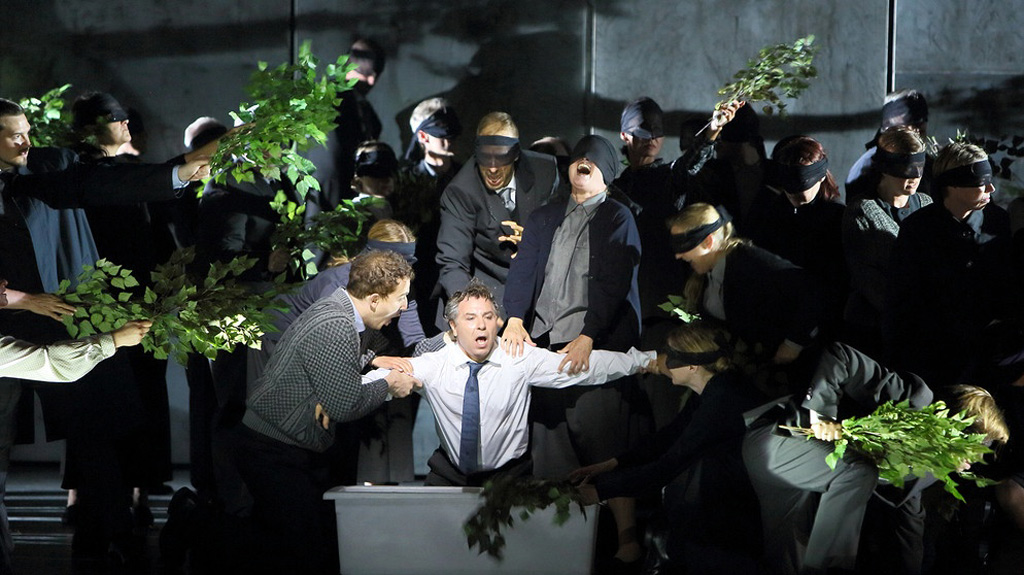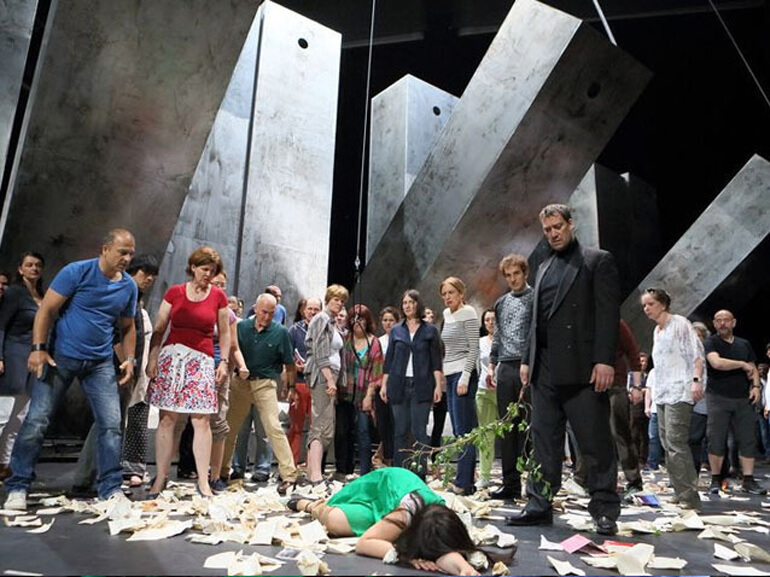
La Juive Aleksandra Kurzak (Rachel), Roberto Alagna (Eléazar), John Osborn (Prince Léopold), Vera-Lotte Böcker (Princess Eudoxie), Ain Anger (Cardinal Brogni), Johannes Kammler (Ruggiero), Tareq Nazmi (Albert). Bayerisches Staatsorchester, Bertrand de Billy, conductor at the National-theater, July 4, 2016.
When I was planning my Munich trip some months ago, La Juive was the deciding factor in my choosing to come to the Festival in early July. Sure, who wouldn’t want to see a blockbuster Tosca with three megastars like Harteros, Kaufmann and Terfel, or Klaus Florian Vogt, the definitive swan knight of our time in Lohengrin? But La Juive was the clincher since it’s not every day that one gets the chance to see this work. I count myself lucky to have seen it twice some years ago at the Wiener Staatsoper and the Met, with the great American tenor Neil Shicoff, in late career, and the beloved Finnish soprano Soile Isokoski, in splendid form. It left me wanting more.
The Munich production, which premiered in late June, exceeded my expectations. What a huge surprise that the Spaniard Calixto Bieito, a Regieoper provocateur whose work I’ve always found problematic, managed to come up with a production that is at once galvanising and soul-searching. Coupled with a superb cast led by the husband and wife team of Roberto Alagna and Aleksandra Kurzak, this opera was, from my vantage point, the most memorable of the 2016 Festival.
Halévy’s La Juive (1835) is a typical 19th century French Grand Opera, a rather unwieldy genre that’s usually five acts plus an obligatory ballet, with a dramatic backdrop often based on some historical event. The librettist was Eugène Scribe, who also penned Meyerbeer’s L’Africaine, Les Huguenots, Le Prophète, as well as Verdi’s Les vêspres siciliennes. Halévy was Jewish, and the theme of cultural and religious intolerance can be found in many of his works. In La Juive, religious fanaticism and intolerance are front and centre. The plot is super-complicated and improbable. Even if some characters are historically based, their story is often entirely fictional. For a detailed synopsis, go to https://en.wikipedia.org/wiki/La_Juive.
Very popular in the 19th century, La Juive languished on the shelf for most of the 20th century, especially during the Nazi era, although to my knowledge it wasn’t banned. At its centre is the religious conflict between Cardinal Brogni and the Jewish goldsmith Eléazar. Added to the mix is the forbidden love between the Christian Prince Leopold and Eleazar’s daughter Rachel, who eventually meets a gruesome death, thrown into boiling water in the original story, but burnt alive in a cage in this production. Not exactly an evening of light entertainment!

Calixto Bieito has updated it to more or less the present time, given the modern dress, unlike the famous Günther Kramer production for Vienna, which I saw. Immediately noticeable is the absence of colours — only black, white and shades of grey, with Rachel’s green dress the only exception. The stage is dominated by an enormous wall, movable as a whole and in sections. It serves as the symbolic Wailing Wall of Jerusalem, and also as a barrier between the Christians and the Jews. There’re hardly any props, with all religious accoutrements gone. Everybody, whether Christian or Jew, wears essentially the same basic black. This severe paring down in the Munich production eliminates visual distractions and allows the audience to focus on the deeper meaning of the piece.
Dated to 1835, La Juive is French bel canto, roughly contemporaneous with Meyerbeer, Rossini, Donizetti, and Bellini. The music is melodic, with set arias, duets, ensembles and large choral forces. Bieito’s radical staging has the effect of taking the audience out of the comfort zone of pretty tunes, forcing them to confront the emotional world of the characters. The overture is cut — instead, it opens with “Te Deum Laudamus.” Pre-recorded and cranked up to fff, the organ and the full chorus are loud enough in the opening to startle, perhaps deliberately. It leads immediately into the first scene, one of forced baptism, with its unforgettable image, a stunning directorial stroke.
Bieito’s staging throughout is never less than striking, evocative, and occasionally shocking. I am referring to the use of video projections of Rachel having her head pushed into the baptismal water; and the projections of words such as Glaube (Faith), Marter (Torture), Rache (Revenge), Erbarmen (Mercy), Sünde (Sin), during the rousing, in-your-face chorus about religious righteousness that ends Act One. In the last few minutes of the intermission, a man comes on to give a sermon, breathing fire and brimstone, with the projection of “Gott ist in Allem” (God is in everything) in the backdrop. But the most galvanizing stroke occurs just before the final scene when Rachel is put in a cage to be burned alive – a grainy, silent video is projected, of a young lamb having its throat cut. This powerful image haunts me to this day.
Given such a visceral production, it almost makes critiquing the voices seem trivial. Kudos to Alagna for a fine Eléazar and a well sung “Rachel, quand du Seigneur,” only a little short on the visceral impact of Neil Shicoff, the most famous exponent of the role. With the cancellation of Kristine Opolais, Aleksandra Kurzak went outside her lyric-coloratura fach to take on Rachel. She gave her all, which was considerable, but there’s no denying that her voice is rather too light for this dramatic soprano role. It is only marginally darker than the Eudoxie of Vera-Lotte Böcker. It would appear it’s not the kind of role Kurzak would want to sing too often. That said, their Act 4 duet, “Ah! Que ma voix plaintive” was a high point of the evening.
American tenor John Osborn was ideal in the thankless role of Prince Leopold, an impossibly high role that goes up to a D in alt. Taking over Princess Eudoxie from Kurzak was the young German soprano Vera-Lotte Böcker, a member of the ensemble in Mannheim. Her bright, silvery tone, fast vibrato, excellent agility and appealing stage presence proved a winning combination. As Cardinal Brogni, German bass Ain Anger took most of Act One to warm up, sounding a bit wobbly. But by the time his big scene with Eléazar came around, he was in fine form, and his acting in this scene with Alagna was heartfelt. At the helm was French conductor Bertrand de Billy, who gave a well-paced and lyrical reading of this daunting score. Even with the overture and the ballet cut and only one intermission, the five-act opera lasted three hours forty minutes. The Munich Opera chorus repeated its fantastic work in Lohengrin.
Now a few comments and observations about the audience reception. I understand there was booing on opening night. There was none in the performance I saw. To say that this opera is timely given the current political situation in Europe is an understatement. The story is very modern yet also very old, wrapped up in European history, and in particular German history. It is undoubtedly a subject that made many in the audience uncomfortable. I made a point of observing them. The people around me were unusually quiet throughout the performance, with little applause after arias, not even when the final curtain came down. It was only when the singers came out for their bows that the audience started to respond generously. In my book, this is a sign that the production is a success. Great art is more than just entertainment but something that’s meant to challenge, confront, provoke, and to leave no room for the complacent.
Read Letters From Munich Part I (Tosca), here, Part II (Lohengrin), here, and Part III (La bohème), here.
#LUDWIGVAN
Want more updates on Toronto-centric classical music news and review before anyone else finds out? Get our exclusive newsletter here and follow us on Facebook for all the latest.
- SCRUTINY | Opera Atelier’s All Is Love Makes Triumphal Return - April 15, 2024
- SCRUTINY | From The Heart: Ema Nikolovska And Charles Richard-Hamelin Offer Unique Program At Koerner Hall - March 26, 2024
- SCRUTINY | The Glenn Gould School Spring Opera Presents A Superb Dialogues Des Carmélites - March 22, 2024



